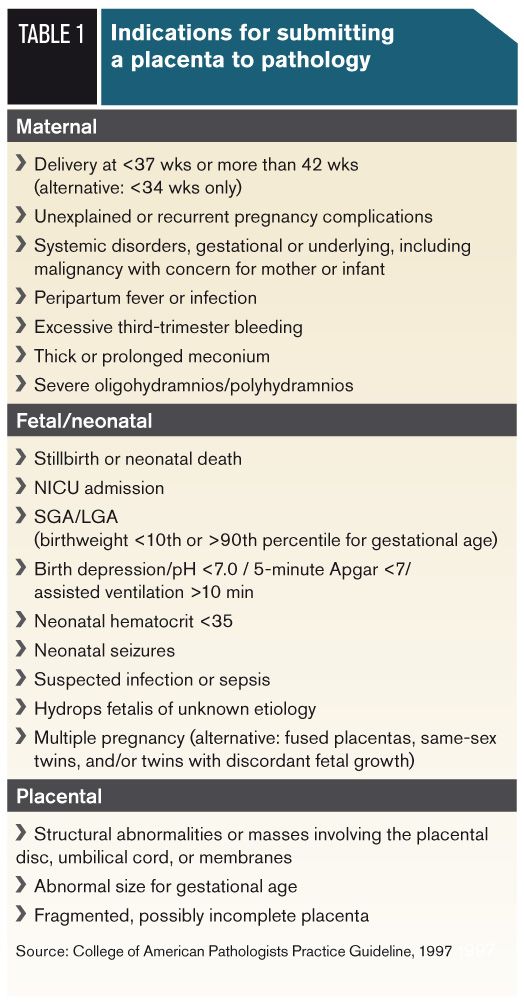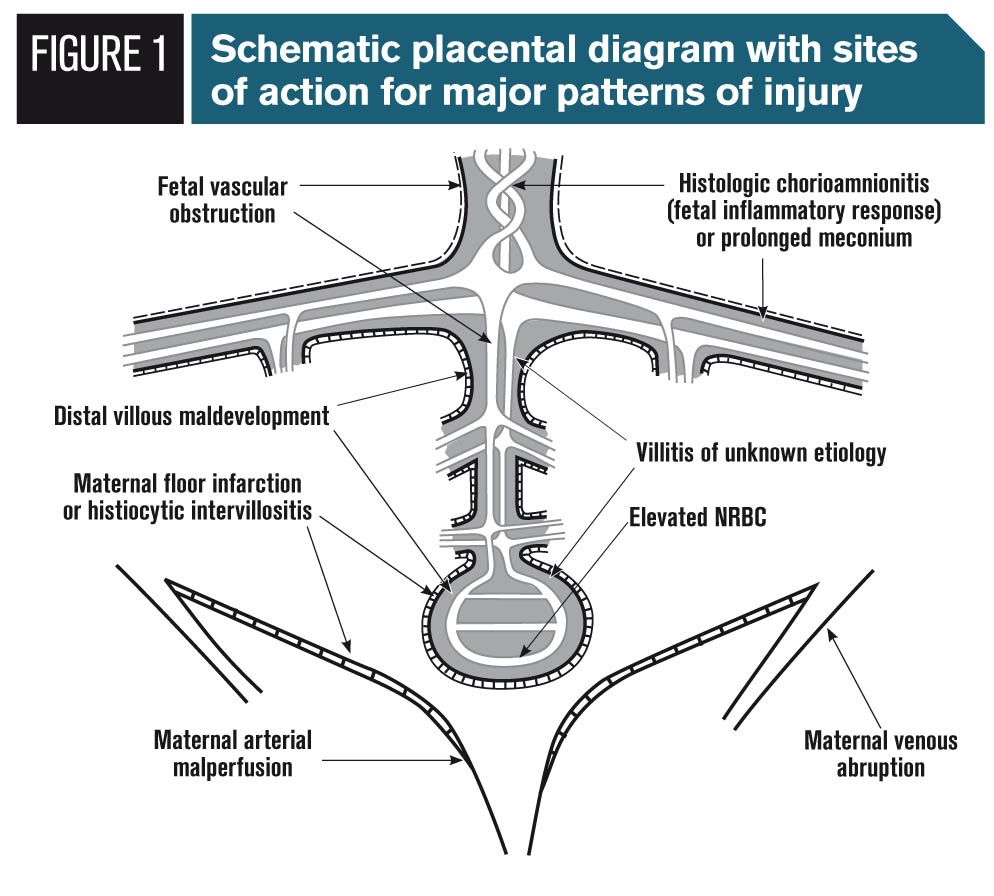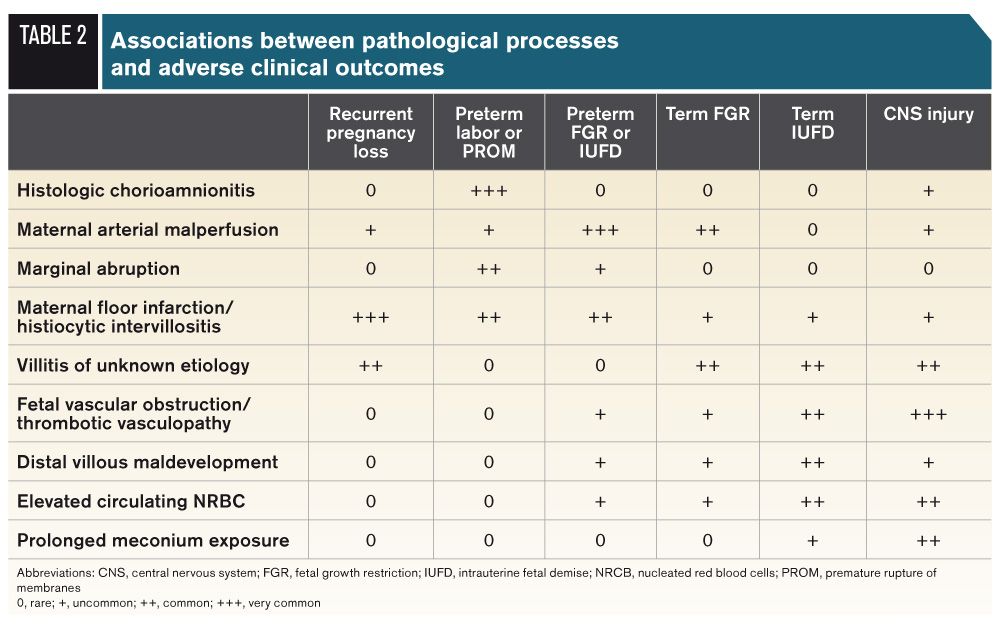Placental pathology: Is it time to get serious?
Opinions differ on the value of sending placentas for pathology examinations. The author calls for standardizing when, why, and how this occurs.
Dr. Redline is a Professor of Pathology and Reproductive Biology at Case Western Reserve University School of Medicine and Section Leader: Gynecologic and Pediatric Pathology, University Hospitals Case Medical Center, Cleveland, Ohio.
He has no conflict of interest to disclose with respect to the content of this article.
Thousands of placentas are submitted to pathology departments across the United States each year at considerable expense to patients and the healthcare system. The benefits derived largely depend on the interest, knowledge, and experience of clinicians and pathologists. Attitudes toward placental pathology vary among clinicians. Some feel it is of no value whatsoever. At the other extreme are those who feel that the placenta is the key to everything if only we understood it.
Attitudes among pathologists range from the opinion “of no interest, simply verify tissue identity” to a belief that all placentas should be examined because their pathology answers every clinical question.
The truth lies between the extremes. We already know a great deal about which patterns of placental injury are clinically important. In specific situations, these data can enhance patient care. Unfortunately, the potential utility of placental pathology is under-realized. On the clinical side, there is lack of clarity regarding which placentas to submit and what placental diagnoses mean. In some pathology departments, there is an appalling lack of diagnostic accuracy and clinical other subspecialty.1
This article discusses the logistics of getting the right placentas to the right pathologists and briefly reviews the most important patterns of placental pathology. The focus here is on 6 common categories of placental injury, 2 rare lesions of extreme severity and high recurrence risk, and 2 placental findings that reflect underlying fetal processes and how they each relate to different adverse pregnancy outcomes. Specialized topics such as multiple gestation, congenital infections, and hydrops fetalis are beyond the scope of this review. Detailed consideration of these and other topics can be found in standard textbooks.2,3 The article concludes with some perspective on how to improve the wide variation in current pathology practice relating to placental diagnosis.
Why send placentas to pathology?
Four categories of placental pathology have clinical utility: (1) findings relevant to the immediate care of the mother or baby; (2) findings predictive of possible recurrence that could guide care in subsequent pregnancies; (3) diagnoses that help explain adverse pregnancy outcomes; and (4) findings that may be important in medicolegal investigation of perinatal mortality and long-term morbidity.
An example of a pathologic finding relevant to immediate care would be a peripheral abscesses on the surface of the umbilical cord in a premature placenta. That is diagnostic for Candida infection, information that should be immediately communicated to the neonatal intensive care unit (NICU) so that antifungal therapy can be initiated. A finding in the second category would be a placenta from a stillborn fetus showing “maternal floor infarction.” Such a lesion is associated with extremely high rates of recurrence and perinatal mortality, risks that can be ameliorated with early surveillance and indicated preterm delivery in subsequent pregnancies. Pertinent to the last 2 categories of placental pathology is neonatal encephalopathy leading to cerebral palsy (CP), which is among the most devastating pregnancy outcomes. Fetal thrombotic vasculopathy indicates antenatal as opposed to intrapartum causation, which can help explain a confusing clinical picture and be informative for both parents and physicians.
Next: Which placentas to send? >>
What placentas should be sent and what should be expected from the pathologist?
The goal is to ensure that the right placentas get to the right pathologist in a timely manner. Guidelines for placental submission were published in 1997 by a task force of pathologists and obstetricians sponsored by the College of American Pathologists (Table 1).4 These are suggestions based on the probability of finding significant patterns of injury, but need to be tempered by the specifics of each pregnancy. Not every placenta from each category needs to be submitted and some placentas that fall outside the guidelines will reveal important findings.

Because some babies present with problems in the days following apparently normal deliveries, it is prudent to develop a system for short-term retention of all placentas on the labor and delivery floor. Placentas can be stored unfixed in a refrigerator for up to 7 days without compromising placental pathology. The importance of providing the pathologist with appropriate clinical history cannot be overemphasized. At a minimum, gestational age, gravidity, parity, birth weight, Apgar scores, and relevant clinical conditions should always be included.
Timely reporting is critical for patient care. If the pathology department receives a placenta by noon, it is not unreasonable to expect a final diagnosis by the end of the next business day. If there are concerns about the accuracy or relevance of the initial placental diagnoses, it may be necessary to discuss the findings with the pathologist and solicit an expert review. Looking down the road, slide scanning technologies that allow for online consultation may facilitate development of regional centers with specific expertise in placental diagnosis.
Common patterns of placental pathology, what causes them, and how they relate to clinical practice
Described below are the constellation of histopathologic findings that either directly affect placental function or serve as biomarkers for processes occurring in the mother or fetus. Figure 1 illustrates their site of action and Table 2 summarizes their correlation with selected important adverse pregnancy outcomes. The relative importance of particular lesions varies in reports by different authors because of varying clinical material, definitions used, and statistical approaches.5-7

Maternal arterial malperfusion develops as a consequence of deficient trophoblastic invasion and remodeling of the spiral arterioles in early pregnancy.8 It is the major cause of early-onset fetal growth restriction (FGR), particularly associated with preeclampsia, indicated early delivery, and stillbirth in preterm pregnancies. It is less common with FGR at term. In some studies, it is a risk factor for CP. Complications include development of maternal preeclampsia due to release of antiangiogenic mediators by ischemic villous trophoblast and abruptio placentae secondary to rupture of inadequately remodeled spiral arterioles.
Placentas affected by maternal arterial malperfusion may be small, both in absolute weight and relative to fetal weight. Histologically, it is characterized by increased syncytial knotting, intervillous fibrin deposition, and villous agglutination. When severe, it is also often accompanied by patchy hypoplasia of the distal villous tree and 1 or more villous infarcts. Features of increased extravillous trophoblasts and multinucleated trophoblasts at the maternal floor also may be evident.5 Recurrence risk is moderate, particularly when associated with early-onset preeclampsia, and affected women should be entered into high-risk screening programs for their next pregnancies.
Abruptio placenta is characterized by large central retroplacental hematomas, often with overlying intravillous hemorrhage or recent villous infarction).5,9 Underlying risks include chronic hypertension and preeclampsia. Marginal abruptions are common causes of spontaneous preterm birth, particularly in the context of ascending infection, and when chronic can be associated with FGR. Chronic abruption is associated with organizing marginal or subchorionic hematomas, circumvallate membrane insertion, and deposition of hemoglobin pigments (usually hemosiderin) in the placental membranes.10

Chronic fetal vascular obstruction, as reflected by the pathologic finding of significant numbers of avascular villi (AV), is a clinically silent process strongly associated with adverse clinical outcome.11 Numerous small foci of AV reflect the effects of globally decreased villous perfusion on the most distal terminal villi and are often seen with other indicators of chronic intermittent umbilical cord obstruction. Larger foci of AV indicate thrombosis of major chorionic or stem villous vessels (fetal thrombotic vasculopathy).
Although maternal diabetes and inherited fetal thrombophilias can be associated with fetal thrombotic vasculopathy, the major risk factor is stasis, again related to compromised umbilical blood flow. Significant numbers of AV are a major risk factor for central nervous system (CNS) injury at term. The frequent finding of large areas of contiguous AV with degenerative changes antedating the estimated time of fetal demise suggests that chronic fetal vascular obstruction is also a major cause of stillbirth at term.7 Significant numbers of AV are a robust indicator of a serious underlying process and can be very helpful in both clinicopathologic correlation and medicolegal contexts.12
Histologic chorioamnionitis is the gold standard for defining the maternal and fetal inflammatory responses to microbial organisms in the amniotic fluid.13 Early inflammation is extremely sensitive and may occur before organisms are detectable in tissue. Clinical symptoms such as fever and leukocytosis are notoriously unreliable in this context. Chorioamnionitis is the major cause of spontaneous preterm birth and other neonatal complications. Assessing the stage and grade of inflammation may help to distinguish between chorioamnionitis as the cause of spontaneous preterm birth and a secondary response following preterm labor and/or rupture of membranes.
Recognizing specific patterns of inflammation can suggest specific organisms, such as Candida or Listeria, that require special attention. Risk of recurrence is low for chorioamnionitis that develops outside of the context of cervical insufficiency. Most cases of chorioamnionitis develop due to ascending infection by cervicovaginal flora, but some may represent hematogenous seeding by oral flora.14 Appropriate periodontal care can potentially decrease recurrence of the latter in subsequent pregnancies.
Villitis of unknown etiology (VUE) is widely believed to be a host-versus-graft response by the mother directed at fetal antigens in the villous stroma.15 This break in fetomaternal tolerance depends on maternal-fetal traffic through defects in the trophoblastic barrier and is promoted by previous fetal antigen exposure (multiparity), degree of antigenic disparity (increased VUE in ovum donation pregnancies), and less specific conditions such as diabetes and obesity. It is largely restricted to the third trimester. A related lesion, chronic chorioamnionitis, recently has been associated with spontaneous preterm birth.16 High-grade VUE (>10 contiguous villi) is associated with term and near-term FGR and, when complicated by inflammatory fetal vascular changes (obliterative fetal vasculopathy), is a major risk factor for CNS injury and stillbirth. VUE has a significant recurrence risk of 20% to 30%.
Distal villous maldevelopment is a more heterogeneous and less well understood category of placental pathology. Distinct patterns include diffuse distal villous hypoplasia, distal villous immaturity (decreased vasculosyncytial membranes), villous capillary proliferative lesions (chorangiosis/ chorangiomatosis), and dysmorphic villi (proximal-distal villous disproportion and abnormal villous contour).17-20 Distal villous hypoplasia is characteristically associated with abnormal uterine artery Dopplers secondary to poor perfusion in villous vessels. The latter 3 processes can all occur independently, but in severe cases often overlap. They represent aberrant morphogenesis of the villous tree in response to environmental factors such as maternal glucose intolerance, smoking, anemia, pregnancy at high altitudes, and air pollution, or genetic/epigenetic abnormalities such as confined placental mosaicism, aneuploidy, or Beckwith-Wiedemann syndrome.
Maternal floor infarction (massive perivillous fibrinoid deposition) and chronic histiocytic intervillositis (massive chronic intervillositis) are extremely rare and poorly understood placental lesions that share 2 characteristics.21-22 They are risk factors for virtually all adverse outcomes ranging from miscarriage to CNS injury, and they have recurrence risks approaching 50% to 75%, meaning that many affected women will never achieve a successful pregnancy. Immunologic, developmental, and genetic etiologies are under investigation with no clear conclusions at this time. Many therapeutic strategies have been proposed, including corticosteroids, aspirin, heparin, other immunosuppressive agents, intravenous immunoglobulin, and paternal leukocyte immunization. There are no controlled studies, but anecdotal evidence supports use of the first 3 agents.
Prolonged meconium exposure and increased circulating nucleated red blood cells (NRBCs) are not true placental lesions but a fetal response to placental hypoxia, independent of its cause. Meconium is released in up to 50% of term and post-term deliveries and does not require placental pathology for diagnosis. However, prolonged meconium exposure, as indicated by a large number of meconium-laden macrophages in the chorionic plate and especially by meconium-associated medial necrosis of chorionic or umbilical vessels, is a recognized risk factor for CNS injury.12,23 Increased NRBCs are detectable within fetal capillaries and can serve as a biomarker for significant fetal hypoxia of at least 6 to 12 hours.24 A placental NRBC count >10 NRBC/10 high-power fields in a term placenta has been shown to correlate with a circulating NRBC count of >2500/mm3 in the infant.
How can we improve the system?
Examination of all placentas by an expert placental pathologist would be ideal, but in this cost-conscious era, submission of placentas could be drastically curtailed if we fail to address current limitations. Progress is required on 2 fronts: Improving the body of evidence about placental pathology and addressing the lack of rigor in placental diagnosis and clinical interpretation while also avoiding oversimplification.
A general framework exists that relates placental lesions to pathophysiology and clinical outcomes, but continuing studies correlating placental phenotypes to specific clinical biomarkers and the underlying placental genome, epigenome, proteome, and interactome are essential. To increase rigor in diagnosis and interpretation, in my view, requires explicit recognition of the value of placental pathology by major professional organizations in obstetrics and gynecology.
Pathology practice will not improve without compelling clinical demand. Assuming that demand can be mustered, the most urgent priorities are establishment of: (1) a uniform system of nomenclature and criteria for the diagnosis and scaling of placental lesions; (2) practice guidelines for the structure of the clinical report; (3) benchmarks for turnaround time; and (4) continuing medical education, evaluation of competency, and appropriate referrals to ensure that placental pathology is diagnosed and interpreted by appropriately trained professionals.
References
1. Sun CC, Revell VO, Belli AJ, Viscardi RM. Discrepancy in pathologic diagnosis of placental lesions. Arch Pathol Lab Med. 2002;126(6):706–709.
2. Kraus FT, Redline R, Gersell DJ, Nelson DM, Dicke JM. Placental Pathology. Washington, D.C.: American Registry of Pathology; 2004.
3. Benirschke K, Burton G, Baergen RN, eds. Pathology of the Human Placenta. 6th ed. New York, NY: Springer; 2012.
4. Langston C, Kaplan C, Macpherson T, et al. Practice guideline for examination of the placenta. Arch Pathol Lab Med. 1997;121:449–476.
5. Stanek, J. Hypoxic patterns of placental injury: A review. Arch Pathol Lab Med. 2013;137:706–720.
6. Stanek J, Biesiada J. Clustering of maternal/fetal clinical conditions and outcomes and placental lesions. Am J Obstet Gynecol. 2012;206:493.e1–8.
7. Stanek J, Biesiada J. Relation of placental diagnosis in stillbirth to fetal maceration and gestational age at delivery. J Perinat Med. [Epub ahead of print, November 21, 2013]. DOI 10.1515/jpm-2013-0219.
8. Redline RW, Boyd T, Campbell V, et al. Maternal vascular underperfusion: nosology and reproducibility of placental reaction patterns. Pediatr Dev Pathol. 2004;7:237–249.
9. Harris BA. Peripheral Placental Separation: A review. Obstet Gynecol Surv. 1988;43:577–581.
10. Redline RW, Wilson-Costello D. Chronic peripheral separation of placenta. The significance of diffuse chorioamnionic hemosiderosis. Am J Clin Pathol. Jun 1999;111(6):804–810.
11. Redline RW, Ariel I, Baergen RN, et al. Fetal vascular obstructive lesions: nosology and reproducibility of placental reaction patterns. Pediat Devel Pathol. 2004;7:443–452.
12. Redline RW. Severe fetal placental vascular lesions in term infants with neurologic impairment. Am J Obstet Gynecol. 2005;192:452–457.
13. Redline RW, Faye-Petersen O, Heller D, Qureshi F, Savell V, Vogler C. Amniotic infection syndrome: nosology and reproducibility of placental reaction patterns. Pediatr Dev Pathol. 2003;6:435–448.
14. Han YW, Fardinin Y, Chen C, et al. Term stillbirth caused by oral fusobacterium nucleatum. Obstet Gynecol. 2010;115(2) part 2:1–4.
15. Redline RW. Villitis of unknown etiology: noninfectious chronic villitis in the placenta. Hum Pathol. Oct 2007;38(10):1439–1446.
16. Kim CJ, Romero R, Kusanovic JP, et al. The frequency, clinical significance, and pathological features of chronic chorioamnionitis: a lesion associated with spontaneous preterm birth. Mod Pathol. 2010;23(7):1000–1011.
17. Fitzgerald B, Kingdom J, Keating S. Distal villous hypoplasia. Diagn Histopathol. 2012;18(5):195-200.
18. Stallmach T, Hebisch G, Meier K, Dudenhausen JW, Vogel M. Rescue by birth: Defective placental maturation and late fetal mortality. Obstetrics and Gynecology. 2001;97(4):505–509.
19. Ogino S, Redline RW. Villous capillary lesions of the placenta: Distinctions between chorangioma, chorangiomatosis, and chorangiosis. Hum Pathol. 2000;31:945–954.
20. Dicke JM, Huettner P, Yan S, Odibo A, Kraus FT. Umbilical artery Doppler indices in small for gestational age fetuses: correlation with adverse outcomes and placental abnormalities. J Ultrasound Med. Dec 2009;28(12):1603–1610.
21. Andres RL, Kuyper W, Resnik R, Piacquadio KM, Benirschke K. The association of maternal floor infarction of the placenta with adverse perinatal outcome. Am J Obstet Gynecol. 1990;163:935–938.
22. Boyd TK, Redline RW. Chronic histiocytic intervillositis: A placental lesion associated with recurrent reproductive loss. Hum Pathol. 2000;31:1389–1392.
23. Altshuler G, Arizawa M, Molnar-Nadasdy G. Meconium-induced umbilical cord vascular necrosis and ulceration: a potential link between the placenta and poor pregnancy outcome. Obstet. Gynecol. 1992;79:760–766.
24. Redline RW. Elevated circulating fetal nucleated red blood cells and placental pathology in term infants who develop cerebral palsy. Hum Pathol. Sep 2008;39(9):1378–1384.
S4E1: New RNA platform can predict pregnancy complications
February 11th 2022In this episode of Pap Talk, Contemporary OB/GYN® sat down with Maneesh Jain, CEO of Mirvie, and Michal Elovitz, MD, chief medical advisor at Mirvie, a new RNA platform that is able to predict pregnancy complications by revealing the biology of each pregnancy. They discussed recently published data regarding the platform's ability to predict preeclampsia and preterm birth.
Listen
